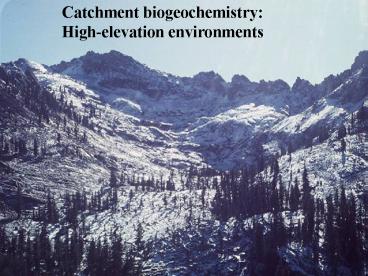Catchment biogeochemistry: - PowerPoint PPT Presentation
1 / 35
Title:
Catchment biogeochemistry:
Description:
Particulate carbon concentrations in the plankton of Emerald Lake are increasing ... Emerald Lake and Lake Tahoe suggests that nutrient loading is altering ... – PowerPoint PPT presentation
Number of Views:77
Avg rating:3.0/5.0
Title: Catchment biogeochemistry:
1
Catchment biogeochemistry High-elevation
environments
2
Environmental issues
Atmospheric deposition Land use changes Climate
change
3
High-elevation catchments of the Sierra Nevada
Many small, shallow lakes with dilute, clear
waterSteep catchments with large areas of
talus, thin soils and sparse vegetationDeep,
seasonal snow cover
4
Characteristics of atmospheric deposition Acidific
ation and eutrophication patterns
5
Atmospheric deposition to the Sierra Nevada
Agricultural and urban sources (local)
Long-range transport
6
Sampling for snow water equivalence snowfall
Sampling snow water equivalence snowfall
represents 85 to 95 of annual precipitation
7
Snowfall varied about five-fold between drought
and El Nino conditions
8
Sampling for chemical composition of snow Snow
is very dilute with ammonium and nitrate low, but
significant constituents
9
Snow Chemistry
- Mean pH 5.4
- Mean ammonium
- 2.7 µM
- Mean nitrate 2.5 µM
10
Sampling for rain chemistry solutes in rain
are about ten times higher than in snow
11
Rain Chemistry
- pH is controlled by strong
- acids HNO3 and H2SO4
- Ammonium and nitrate
- concentrations are high
12
Rainfall is highly variable and about 10 of
snowfall
13
Deposition by rain and snow are similar (with
exceptions)
14
Comparative studies of high-elevation lakes
Regional surveys and multi-year studies of
selected lakes (1980 to 2003) Low acid
neutralizing capacity, but acidic atmospheric
deposition not causing chronic acidification of
lakes An ANSWER the California Air Resources
Board can use for management and policy
15
Is the nutritional status of high-elevation
lakes changing? Long term measurements at
Emerald Lake Comparison of regional surveys
16
Particulate carbon concentrations in the plankton
of Emerald Lake are increasing
17
Phosphorus-loading is increasing
18
Phytoplankton have become more N-limited
19
Nutrient loading is increasing
20
Where is additional P coming from?
- Localized atmospheric sources can be ruled out
- Atmospheric source must be regional in scale
- Could also be change in internal rate of
P-cycling - Pesticides ruled out
- China dust?
21
Site-specific or regional trend?Nitrate has
declined in other lakes
22
And phosphorus levels have increased
23
Nutrient deposition seems to pose a greater
threat to wilderness lakes than acidic
deposition Lakes in the Sierra Nevada have
very low concentrations of nutrients and
long-term monitoring at Emerald Lake and Lake
Tahoe suggests that nutrient loading is altering
phytoplankton productivity
24
Sampling High-elevation lakes While
ice-covered, lakes receive snowmelt runoff
25
Episodic nitrate pulses
26
Episodic Acidification
- Lakes undergo decline in acid neutralizing
capacity (ANC) during spring snowmelt and during
large (gt5 cm) rainstorms in the summer - Dilution (decreasing base cation concentrations)
was the primary factor in ANC depression during
snowmelt, accounting for 60-95 of the ANC
reduction - Acidification (increasing acid anion
concentrations) accounted for 5-40 of the
snowmelt ANC depression - nitrate plays a key
role in this process
27
Californias Future Climates?
- High Certainty
- Warmer, more warming in winter than summer
- Medium certainty
- Increased winter precipitation, increased
fraction falling as rain vs. snow - Lower Certainty
- Greater interannual variability, stronger or more
frequent ENSO, more convective storms
28
N-cycling in high-elevation ecosystems is
sensitive to climatic variation
29
Nitrate pulse hypotheses in snow-covered
catchments
- Snowpack Elution
- Physical process
- Ion migration within snow crystals
- gt40 of nitrate lost during initial 10-20 of
melt
- Soil Flushing
- Biologically mediated
- Product of microbial mineralization and
nitrification - Transport to streams during initial snowmelt
flush
Courtesy of USGS BRD
30
Approaches to testing conceptualhypotheses in
Sierran catchments
- Catchment input-output budgets
- Dual-isotope measurements of nitrate
(d18O and d15N)
31
Approach 1Catchment input-output budgets
- Detailed and temporally-intensive measurements
of - Catchment outflow losses-
- Hourly discharge
- Daily chemical samples
- Snowmelt inputs-
- Snow distribution from surveys
- Sequential snowpacks to estimate snowpack elution
- Computations done from the start of snowmelt
through peak nitrate concentration
32
Nitrogen budget results
33
Dual isotope principal
34
Dual isotope data Sierra Nevada
35
Conclusions from nitrate pulse studies
- Patterns of nitrate export are primarily
controlled by microbial uptake and release and
by elution rate from snowpack - Both snowpack and soil nitrate are found in
streams during nitrate pulses - About 30-50 of snowpack nitrate escapes
biological cycling owing to vegetation senescence - Triggers for microbial N-release are still not
fully understood - Soil freezing
- Substrate limitation
- Species shifts
- Redox conditions































